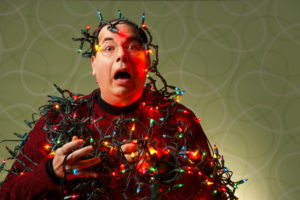 Communities developed by Hartz Homes become beautifully illuminated over the holidays. Some of the residents are old pros with holiday decorations and lighting. But, there are also novices that can be overwhelmed with the task. Have no fear! Here are some tips for hanging outdoor lights that can help people regardless of skill level. Soon, even the first-timer can step back and enjoy a masterpiece!
Communities developed by Hartz Homes become beautifully illuminated over the holidays. Some of the residents are old pros with holiday decorations and lighting. But, there are also novices that can be overwhelmed with the task. Have no fear! Here are some tips for hanging outdoor lights that can help people regardless of skill level. Soon, even the first-timer can step back and enjoy a masterpiece!
First, measure the locations where you will string lights. Most likely this will be along eaves or gutters and around windows. Use these measurements to estimate how many strands you’ll need and how long they should be. Unfortunately, there are no standard strand lengths, but there are standard-size bulbs and standard distances between bulbs on a strand. Look for C7- or C9-size bulbs spaced 6 to 8 inches apart. (A longer distance between bulbs allows for more light to spread across a wider area, creating more picturesque shadows and greater warmth.)
Another option for outdoor lighting is “miniature bulbs,” which costs less and consumes less power than the classic outdoor light string. They can be used around the perimeter of your home, as well as in trees. In most cases, the miniature bulbs come in strands of 50 or 100. The strings run in series, which means if one bulb or socket fails, you can lose a whole section.
Regardless of the style of lights you choose, always use waterproof or water-resistant lights with a tag marked underwriters lab (UL). This means the lights meet national industry standards with the American National Standards Institute. Also, when you’re buying Christmas lights to use outside, make sure they are rated for outdoor use (just like your extension cords). Never use indoor Christmas lights outdoors.
When installing the lights on the house, place the first bulb from the male end of a strand on the corner of your eave that’s closest to an outlet. Then, extend the line around the exterior of the house, keeping the string taut. Secure the lights with gutter clips so they don’t creep up the roof. These are cheap, so buy a bunch. A discreet extension cord will connect the lights to the outlet.
To light shrubs and bushes, net lighting is a great way to go. Net lighting is a mesh of interconnected mini LED lights that can drape right over your shrubs like a blanket. No more weaving light strings in and out of branches!
However, you might think that net lights are a cop-out. I this is you, then wrap regular “mini-lights” around the trunk and branches. To determine how many feet of lighting you need, divide the height of the trunk by the desired spacing between each strip of lights; about 3 inches is ideal. Then multiply that number by the trunk’s circumference. Do the same calculation for any large branches you want to wrap. First, wind the lights up the tree, leaving about 6 inches between each pass. Continue on to the branches, then wrap back down into the empty spaces. That will give you the desired 3-inch spacing. So, for a 6-foot-tall trunk with a circumference of 2 feet, divide 72 inches by 3 inches of spacing, for a total of 24. Multiply 24 by the 2-foot circumference, for 48 feet of lights.
When using extension cords, make sure they are also rated for outdoor use, and keep the connections above ground, snow and water. Most blown fuses are caused by moisture getting into the connectors that attach strings of lights to each other. Sealing each connection and the loose ends of a string with duct or electrical tape will keep everything dry.
Try to avoid placing extension cords in high-traffic areas. Tape cords across walkways, and use the correct length needed to travel to your lights. You don’t want your cords to be too long so they pile up and create walking hazards.
BONUS TIP: When it’s time to take the lights down, avoid the dreaded “Clark Griswold knot of lights” by wrapping your strings around coffee cans before storing them.
Please check out these new home communities from Hartz Homes:
Armitage Pointe of Addison, Illinois (Chicago area new home construction)
Bella Vista Townhomes of Bolingbrook, Illinois (Chicago area new home construction)
Lago Vista of Lockport, Illinois (Chicago area new home construction)
Leigh Creek of New Lenox, Illinois (Chicago area new home construction)
Marquis Pointe of Montgomery, Illinois (Chicago area new home construction)
Marywood Meadows of Montgomery, Illinois (Chicago area new home construction)
Nantucket Lakes of New Lenox, Illinois (Chicago area new home construction)
Oliviabrook of Oakbrook Terrace, Illinois (Chicago area new home construction)
Park West of Manteno, Illinois (Chicago area new home construction)
Playa Vista of Plainfield, Illinois (Chicago area new home construction)
Shannon Estates of New Lenox, Illinois (Chicago area new home construction)
Sky Harbor of New Lenox, Illinois (Chicago area new home construction)
Whisper Creek of Mokena, Illinois (Chicago area new home construction)
Hartz Homes has new home communities in:
Addison, Illinois (Chicago area new home construction)
Aurora, Illinois (Chicago area new home construction)
Bolingbrook, Illinois (Chicago area new home construction)
Lockport, Illinois (Chicago area new home construction)
New Lenox (Chicago area new home construction)
Manteno, Illinois (Chicago area new home construction)
Mokena, Illinois (Chicago area new home construction)
Montgomery, Illinois (Chicago area new home construction)
Plainfield, Illinois (Chicago area new home construction)
Oakbrook Terrace (Chicago area new home construction)
